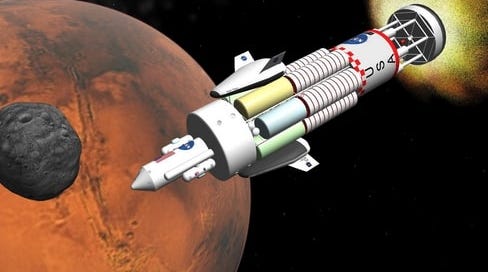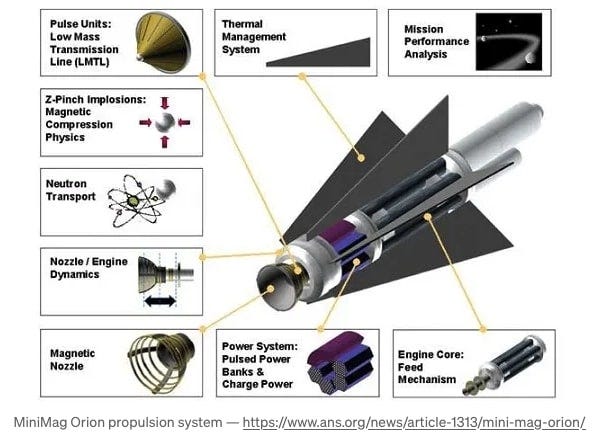Nuclear pulse propulsion is a technology that would work. It was being developed in the 1960s but it was stopped because of the nuclear test ban treaty and concerns over fallout inside the magnetosphere of the earth. The reasons not to use Project Orion or to not massively rely on nuclear power fade away on Mars, the moon and the rest of the solar system. The negatives decrease and the positives remain or even increase.
Negatives that go away or will not matter
- worry about too many nuclear bombs for war. The nuclear bombs would be far away. Nuclear bomb use for solar system propulsion would not be more dangerous than any means of faster propulsion for space ships.
- worry about fallout. Fallout only matters for nuclear bombs exploded in an atmosphere with people where people are directly breathing from the atmosphere
Positives.
- Nuclear pulse propulsion would enable propulsion that can be 200 to 800 times faster than chemical propulsion
- Even crude nuclear pulse propulsion is 2 to 10 times faster than chemical propulsion for in solar system travel.
- nuclear is needed for energy past Mars
Mining the Materials and Reviewing How We Would Do It
I present evidence and belief that there is Uranium all over the solar system. There is the material for nuclear fission bombs and nuclear fusion bombs.
- There is uranium throughout the Earth's crust and the solar system formed from the same material. Missions to the moon and Mars have detected uranium.
- Uranium could be collected and Nuclear bombs could be made on the moon and Mars. Those bombs could be used to make the pulsed propulsion that could launch from the moon or Mars.
- If the average distribution in the Earth's crust of 2.7 parts per million was the same on the Moon and Mars, then one would expect some areas to be more concentrated by 10 to 100 times.
- In-situ leaching (ISL) is a well-established method used to extract uranium from low-grade deposits without physically removing the ore from the ground. A solution (typically containing acid, such as sulfuric acid, or an alkaline agent, like sodium bicarbonate, depending on the geology) is injected into the uranium-bearing rock through wells drilled into the deposit. The acid dissolves the uranium into a soluble form (e.g., uranyl ions).
ISL works for low-grade uranium deposits. It has been successfully on earth for uranium deposits with grades as low as 0.02% (200 ppm).
ISL works best in permeable rock formations, such as sandstone-hosted deposits, where the leaching solution can flow through the ore. Many low-grade uranium deposits in the crust, especially those slightly more concentrated than the average, occur in such formations.
Advancing Nuclear Pulse Propulsion
The original Project Orion used fission bombs, yielding a specific impulse (Isp) of 2,000 to 6,000 seconds (exhaust velocities of 20–60 km/s). For interstellar travel, fusion bombs are necessary due to their higher energy output and debris velocities (estimated at 3,000–30,000 km/s). Freeman Dyson suggested in his 1968 paper "Interstellar Transport" that fusion bombs could achieve effective exhaust velocities of 750–7,500 km/s, depending on pusher plate efficiency.
Getting to 1% of the speed of light, tens of thousands of bombs, each potentially 1 ton (as Dyson proposed), would be required.
The Super Orion was a scaled-up version of the original Orion concept. It planned for a 8-million-ton giant with a 400-meter-diameter pusher plate. For interstellar missions, the Super Orion could achieve a top speed of approximately 3.3% of the speed of light, or about 10,000 km/s.
Mini-mag Orion and Other Designs
Andrews Space in the early 2000s proposed Mini-mag orion. Mini-Mag Orion uses magnetic fields to compress and ignite small nuclear pellets, offering a more controlled and potentially more efficient alternative to the traditional pusher-plate design. This approach could reduce the spacecraft's size while maintaining high thrust and specific impulse (up to 10,000 seconds).
NASA’s Innovative Advanced Concepts (NIAC) program, PuFF (Pulsed Fission-Fusion) uses small fuel pellets that undergo both fission and fusion reactions, initiated by a Z-pinch mechanism. This hybrid approach aims to achieve higher specific impulse and thrust compared to traditional nuclear pulse designs.


Interstellar Orion Ship
A ship with 10,000 tons of payload (e.g., crew, life support, scientific equipment). A mass ratio of 2 with ve = 5,000 km/s yields an initial mass of 20,000 tons, including 10,000 tons of bombs (10,000 one-ton bombs). Larger payloads, like Dyson’s 100,000-ton example with 300,000 bombs (total mass 400,000 tons), could reach 3,000 km/s with ve ≈ 7,500 km/s and a mass ratio of 1.5 (150,000 tons initial mass). The Super Orion concept scaled up to 8 million tons, envisioned as a city-sized ark with a 20-km-diameter pusher plate.
Physical Dimensions: The pusher plate size scales with mass and bomb yield. The 4,000-ton Orion had a 25-meter-diameter plate; a 20,000-ton ship might require a 50–60-meter plate, while a million-ton ship could need hundreds of meters. The 8-million-ton Super Orion’s 20-km plate reflects extreme scaling for massive payloads or lower speeds.
Achieving over 1% of light speed is plausible with fusion bombs and a mass of hundreds of thousands to millions of tons, depending on payload and efficiency. A 150,000-ton ship with 50,000 tons of bombs (50,000 bombs) and 100,000 tons of payload is a balanced estimate.
Solar System Missions (10–180 Days)
Fission-based Orion (4,000 tons) for most missions (e.g., Mars in 125 days, Jupiter in 180 days). Fusion-based for fast outer-planet trips (e.g., Jupiter in 30 days).
They would be thousands of tons, with 25–50-meter pusher plates, using hundreds to thousands of bombs.
Keep reading with a 7-day free trial
Subscribe to next BIG future to keep reading this post and get 7 days of free access to the full post archives.






